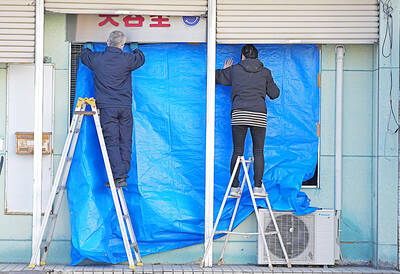Protesters yesterday took to the streets in Taipei in support of the international campaign March Against Monsanto, calling on the government to maintain strict regulations on genetically modified organisms (GMO) in foods.
GMO foods will be a critical issue in negotiations on agricultural trade between Taiwan and the US to be held in September, a Chinese Nationalist Party (KMT) legislator said.
The first, US-based, March Against Monsanto in 2013 garnered support from more than 2 million protesters worldwide who protested against the US biotechnological multinational, which produces genetically modified plant species and herbicides.
Tami Canal, the initiator of the movement, has been campaigning to promote organic food production and for the labeling of products containing GMO ingredients.
The Homemakers United Foundation joined the movement yesterday to lead the march, which ended at the Water Garden Organic Farmers’ Market.
“GM foods and 80 percent of the herbicides [used by local farmers] pose health risks,” said Warren Kuo (郭華仁), a professor at National Taiwan University’s Department of Agronomy, adding that Monsanto’s and the US government’s support of GMO foods was scientifically untenable.
Since 2008, Kuo has been working with the foundation, the Green Formosa Front and a few lawmakers to call for regulation of GMO foods.
Their efforts were rewarded in 2015, when the government amended the School Health Act (學校衛生法) to keep genetically modified and heavily processed foods from reaching educational institutions.
Kuo said the government must not bow to pressure from the US, who he said has called for abolishing the ban on GMO foods in schools under the pretext that it constitutes a barrier to trade.
“As long as the US can offer quality soy beans at a reasonable price, we are willing to purchase them. There is no such thing as a trade barrier,” he said.
Chinese Nationalist Party (KMT) Legislator Lee Yen-hsiu (李彥秀) said the government would likely be pressured on the issue of GMO foods and meat products containing ractopamine during the negotiations in September, adding that people should work together to let the US know Taiwanese do not want these things, and that she would raise the issues again in the Legislative Yuan on May 31.

Taiwanese were praised for their composure after a video filmed by Taiwanese tourists capturing the moment a magnitude 7.5 earthquake struck Japan’s Aomori Prefecture went viral on social media. The video shows a hotel room shaking violently amid Monday’s quake, with objects falling to the ground. Two Taiwanese began filming with their mobile phones, while two others held the sides of a TV to prevent it from falling. When the shaking stopped, the pair calmly took down the TV and laid it flat on a tatami mat, the video shows. The video also captured the group talking about the safety of their companions bathing

US climber Alex Honnold is to attempt to scale Taipei 101 without a rope and harness in a live Netflix special on Jan. 24, the streaming platform announced on Wednesday. Accounting for the time difference, the two-hour broadcast of Honnold’s climb, called Skyscraper Live, is to air on Jan. 23 in the US, Netflix said in a statement. Honnold, 40, was the first person ever to free solo climb the 900m El Capitan rock formation in Yosemite National Park — a feat that was recorded and later made into the 2018 documentary film Free Solo. Netflix previewed Skyscraper Live in October, after videos

Starting on Jan. 1, YouBike riders must have insurance to use the service, and a six-month trial of NT$5 coupons under certain conditions would be implemented to balance bike shortages, a joint statement from transportation departments across Taipei, New Taipei City and Taoyuan announced yesterday. The rental bike system operator said that coupons would be offered to riders to rent bikes from full stations, for riders who take out an electric-assisted bike from a full station, and for riders who return a bike to an empty station. All riders with YouBike accounts are automatically eligible for the program, and each membership account

A classified Pentagon-produced, multiyear assessment — the Overmatch brief — highlighted unreported Chinese capabilities to destroy US military assets and identified US supply chain choke points, painting a disturbing picture of waning US military might, a New York Times editorial published on Monday said. US Secretary of Defense Pete Hegseth’s comments in November last year that “we lose every time” in Pentagon-conducted war games pitting the US against China further highlighted the uncertainty about the US’ capability to intervene in the event of a Chinese invasion of Taiwan. “It shows the Pentagon’s overreliance on expensive, vulnerable weapons as adversaries field cheap, technologically